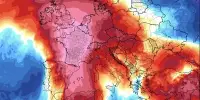The Mid-Pleistocene Transition (MPT), during which the main climatic cycle prolonged and intensified, has had a significant impact on the planet we live on. Instead of occuring every 41,000 years, ice ages began to occur every 100,000 years, and protracted cold periods became colder. New evidence points to a surprise suspect: continental shelf erosion in the North Atlantic. Milankovich cycles, modest variations in the Earth’s orbit and polar orientation, controlled the transition between glacial and interglacial eras until humans started interfering with the planet’s thermal balance. The 100,000-year climatic cycles we see now are the result of a mixture of three cycles with varying phases.
Paleoclimatologists assumed Milankovich cycles were different when they discovered glacial cycles used to be substantially longer. That may have been true when dinosaurs were supreme, but the evidence suggests otherwise in the early Pleistocene.
Instead, according to a report published in the Proceedings of the National Academy of Sciences, the change occurred in the seas when the Atlantic Meridional Overturning Circulation (AMOC) lost a significant amount of its force.
The Gulf Stream, which transports warm water up the American coast before heading east, is the most well-known component of the AMOC. It is why Northern Europe has a far more acceptable climate than everywhere else does in the world at similar latitudes.
Because of its high density, the water cools and sinks, carrying massive amounts of carbon with it before moving south well below the surface. The Global Thermohaline Circulation, which includes AMOC, is a considerably broader phenomenon.
AMOC’s strength decreased in the Mid-Pleistocene, although whether this related to the MPT has been a point of contention among geologists. For her at Columbia University, Dr. Maayan Yehudai investigated the intensity of AMOC across time using deep-sea sediments from the north and south Atlantic. “What we discovered is that the North Atlantic was operating extremely differently than the rest of the basin immediately before the catastrophe,” Yehudai said in a statement.
According to Yehudai and co-authors, the ultimate cause of this event is something that may appear to be an unlikely driver of global change: the removal of soils deposited on Europe and North America’s continental shelves. According to a long-held theory, these soils made the continental outskirts slick, allowing glaciers to easily slide over them.
The theory goes that repeated ice ages eroded away the topsoil until the glaciers were lying on bedrock, which made them much more stable. During cold times, the stabilized glaciers thickened and were less prone to melt completely during brief warm episodes.
They continued to reflect light, cooling the earth and preventing shorter interglacials from reaching their full potential. As a result, breaking the ice’s grip required a more strong combination of orbital cycles, and the coldest times grew colder.
The findings of the researchers have given credence to what was previously a hypothetical hypothesis. Although causation between more stable ice sheets, a weaker AMOC, and a longer glacial cycle is difficult to prove, the chronology they provide is undoubtedly intriguing. From 980-950 million years ago, there was a period of extreme erosion over the North Atlantic, which followed by a dramatic drop in AMOC strength and the first 100,000-year-long glacial cycle.
The findings also support the idea of a rapid MPT rather than one that took 600,000 years, as others have hypothesized. “We don’t completely comprehend one of the most significant climatic changes,” Yehudai remarked. Addressing this is critical for our ability to forecast future climate change since a further weakening of the AMOC expected to become major once more.















